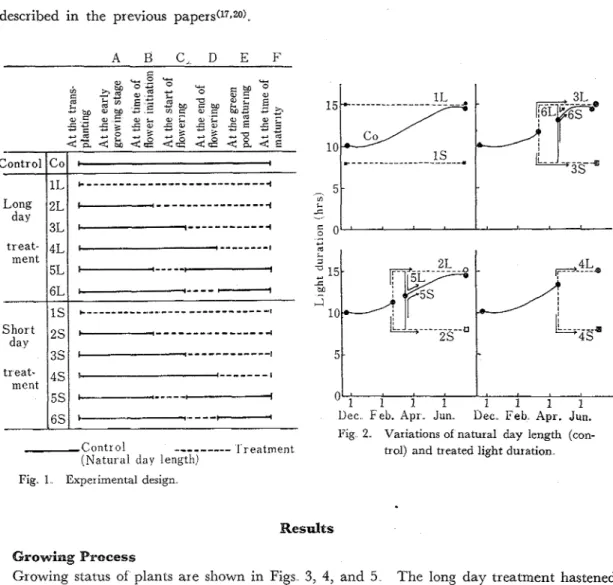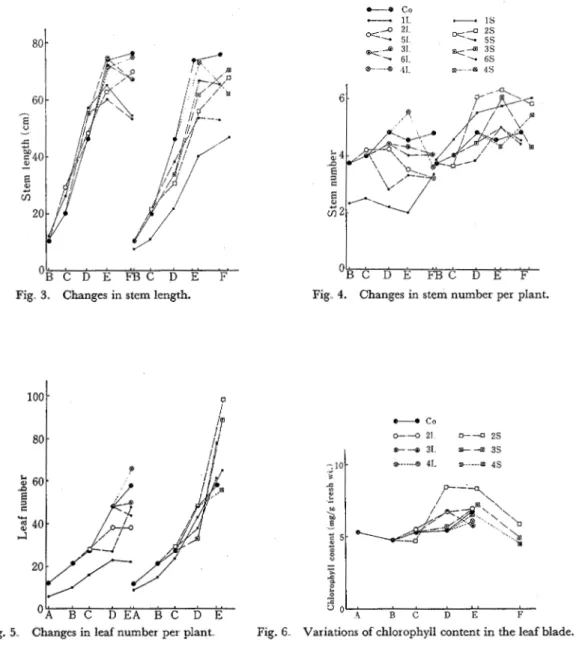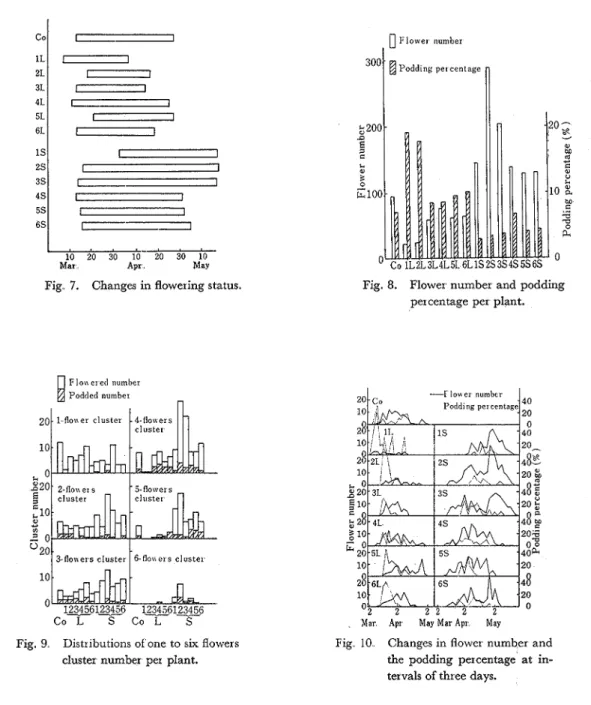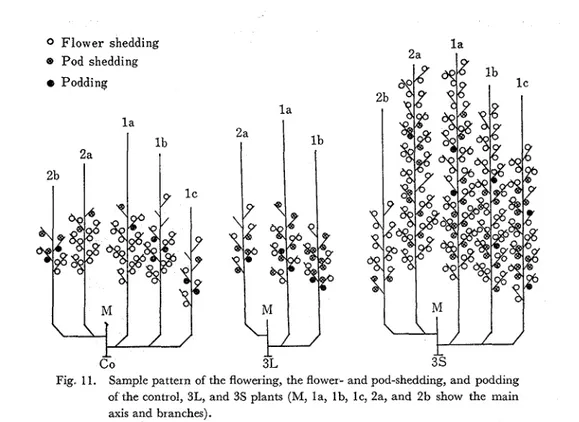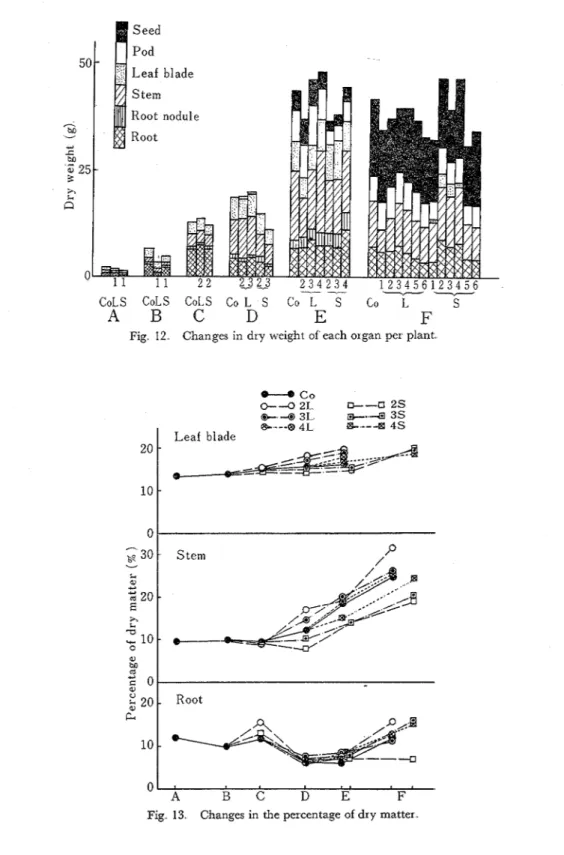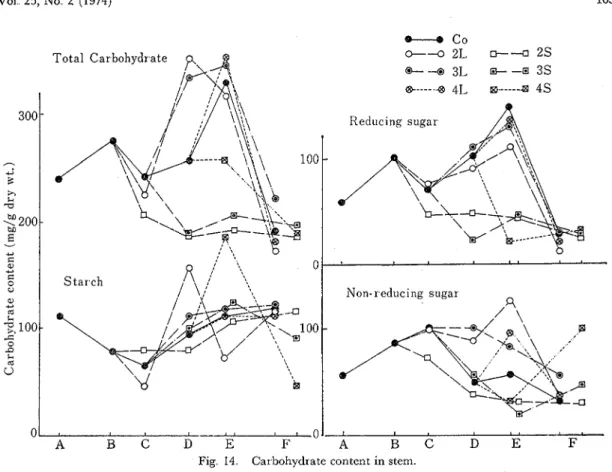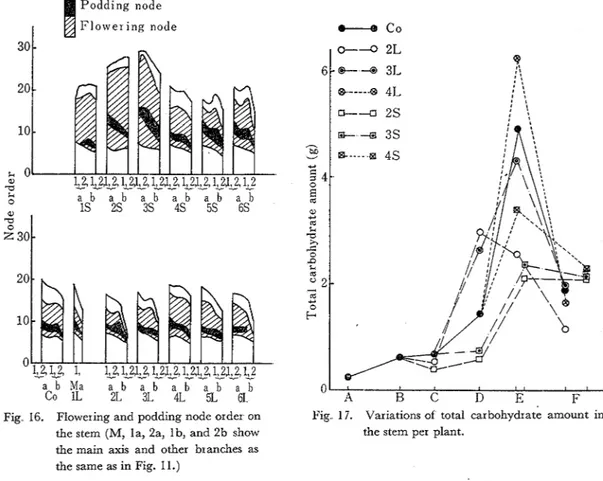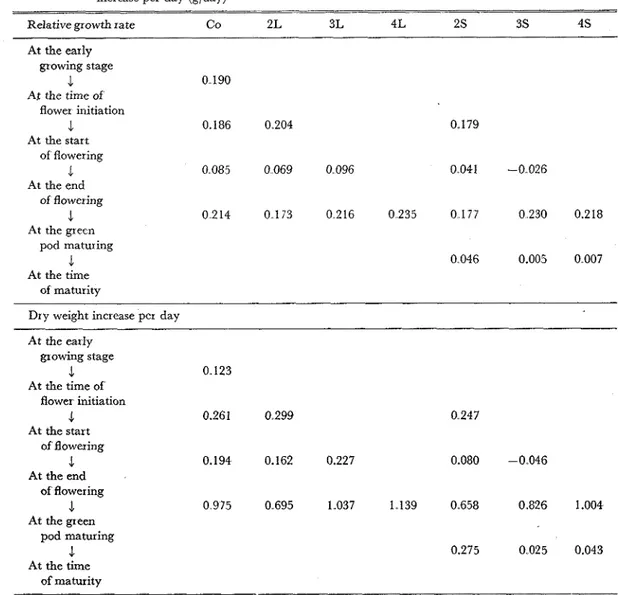PHYSIOLOGICAL STUDIES O F T H E GROWING PROCESS O F BROAD BEAN PLANTS ,-
V I I I Effects of' the Length of' Light Duration on the Growth and the Chemical Components
Kiyoshi TAMAKI, Junzaburo NAKA and Koh-ichiro ASANUMA
Many investigations concerning with the photoperiodism of broad bean plants (Vzcia faba) have been reported and have resulted in disagreement in the responses(6.8~10~11~12~22). I t
might be owed to the sample stocks of different geographycal origins, appreciated by Evans@) and PgScenko(ll), who classified the varieties of various geographycal origin into four groups according to the flowering responses; long-day, short-day, day neutral, and intermediate. I n recent years, Evans(6), Icagawa (a), Eanger et a1. (9), and P2s'cenko(lo) examined that, in broad
beans, the flower initiation showed the long-day response as well as the low temperature re- sponse, and a t the same time the development of the vegetative organs were affected by those two factors. On the other hand, the studies on the photoperiodic response in various plants from the point of physiological changes, which are increasing since the Klebs' research (1904) a t the beginning of this century, are progressed in the respective sphere of the macro and the specific chemical components including the nucleic acid and the growth substances(l.4.14.15~16).
Therefore, the object of this investigation was to examine the effects on the growth, the flower- ing and podding habit, and the physiological status especially of the carbohydrate contents in the various organs, attributable to the change of the length of light duration. I n the present experiment, the treatments of the lengthening and shortening light duration were imposed on plants.
Materials and M e t h o d s
Broad beans, cultivar "Sanuki-nagasaya", were sown at nursery bed on November 5, and the seedlings were transplanted two plants per pot on December 3 Each pot received 2.0 g ammonium sulfate, 3 4 g superphosphate, and 1.3 g potassium sulfate Soil moisture was maintained about 80% of field capacity.
Experiments were conducted in non-heated glass house The experimental design is shown in Fig. 1; plants were subjected to thirteen treatments including natural day length (control) condition. I n the long day condition, the light duration was lengthened to 15 hours per day and the treatment was accomplished about 4500-7000 Lux with supplemental illumination of two mercury lamps (HF-400) and two incandescent lamps (200 W) a t night On the other hand, in the short day condition, the light duration was shortened to 8 hours per day and the treatment was accomplished by mounting in horizontal position 180 cm above the ground and by surround- ing with black vinyl sheet from 5 pm. till 9 am The variations of light duration receiving the experimental plants are shown in Fig
2
Except for the first treatment (IL, IS), the main axis was removed in winter and branches were used for experiments. Plants were sampled a t six times. The sampling techniques and other experimental details including the chlorophyll and the carbohydrate analyses were the same as
158
described in the previous papers(l7.20).
A B C D E F
Tech.. Bull. Fac.. Agr. Kagawa Univ.
control
ICOI
I 1Short
12s/
-,
day
Control
.---
Treatment(Natural day length)
Fig 1 Experimental design
~ ' i
i
i
i
I , 1 1 1 1-
Llec. Feb. Apr.. Jun.. Dec.. Feb. Apr. Jun.
Fig 2. Variations of natural day length (con-
trol) and treated light duration
Results
Growing Process
Growing status of plants are shown in Figs 3, 4, and 5 The long day treatment hastened the elongation of the stem temporarily but the short day treatment prevented, and the stem length was finally lowered by both treatments Though the stem number increased from the early growing stage till the start of flowering under the condition of natural day length, the in- crease was retarded under the long day condition in contrast with the results of the short day condition With regard to the leaf number, accordingly, there were marked increases on the plants under the short day conditions, especially treatments of 2S and 3s. Therefore, the plants grown under the long day condition obtained the dwarfing habit with less leaf numbers and longer internodal stems and the early maturating habit, contrary to the plants grown under the short day condition:
The variations of chlorophyll content in the leaf blade are shown in Fig. 6, The contents were heightened temporarily by the long day treatment but thenceforth were lowered, especially in 3L While, in the short day conditions, the contents progressed later but considerably high value, especially in 2S
The Aowering and podding status varied markedly concerning with the treatments The flow- ering began earlier about a week by the long day treatment of 1L but later about a week with
Vol.. 25, No. 2 (1974) 159 that of the control or other treatments (Fig. 7) The flowering period per plant was generally reduced by the long day treatments but increased by the short day ones Moreover, these tendencies were emphasized when the treatments were started a t the time of flower initiation till the start of flowering
The flower number per plant and podding percentage are shown in Fig. 8 The figure shows that the long day treatments decrease the flower number but increase the podding percentage, and under the short day conditions the reverse takes place. I n conjunction with the flower number, there were found a few developing flowers per cluster under the long day conditions, but much flowers of the initiated inflorescence developed under the short day conditions, as shown in Fig. 9. The flower number and the podding percentage at intervals of three days are shown in Fig 10 Comparing with the control plants, the flowering in the plants grown under the long day conditions was found mainly a t the early part of the flowering period and made
e- 9 21 la- a 16
Fig 3. Changes in stem length. Fig 4. Changes in stem number per plant.
100 w C o 80 0 - 4 2 1 & - - a 2 5 - 1 0 - 5 60 0 4
5
U 2 40i
-
j
5 - 4 20-
-
h r:-
5 0 6 - 4 3 1 E - 4 3 5 e- - - - 8 41 la- -- a 4 s F---Y,a\+b
,--d '>
, 'A B C D E A B C D E 4 B C D E FTech. Bull. Fac. Agr. Kagawa Univ.
--
io $0io
Mar Apr May
Fig. 7. Changes in flowering status,
F I O U er ed number Podded number
n 20
I
1 floner cluster 4.flonersFig. 9. Distributions of one to six flowers cluster number per plant.
Flower number
300.
\ P o d d i n g percentage
Fig. 8. Flower number and podding
per centage per plant.
-1 louer number
. Mar Apr May Mar Apr May
Fig 10 Changes in flower number and
the podding percentage a t in- tervals of three days.
the fertile pod, after all. On the contrary, in the plants grown under the short day conditions especially 2 s and 3S, the flowering peaks were recognized in twice, but the peak of the podding percentage was not found clearly. Fig. 11 shows the sample pattern of the flowering, the pod shedding, and the podding of the plants. The developments of the pod and seed were influenced by both lengthening and shortening light duration; the pod number varied in connection with the stem number or pod bearing stem number, and the 100 seeds weight were lowered by both treatments especially short day ones (Table 1).
The dry weight per plant and its distribution of each organ at every sampling time is shown in Fig. 12. Although the dry matter accumulation in the vegetative organs from the end of flow-
Vol. 25, No. 2 (1974)
0 Flower shedding
@ Pod shedding
8 Podding
Fig. 11. Sample pattern of the flowering, the flower- and pod-shedding, and podding of the control, 3L, and 3s plants (M, la, lb, lc, 2a, and 2b show the main axis and branches).
Table 1.. Effects of light duration on the pod and seed
-- --- - - -
Pod Pod Seed Seed 100 seeds
number
*
length number dry weight weight(cm) per pod (g)
*
(g) Control Co 6 5 12.0 3.1 18.3 104.2 -- - -- 1 L 4 0 12.0 3.6 17.5 93.2 2L 4.5 11.4 3.3 16 2 91.8 Long 3L 5 0 11.0 2.7 15 8 104.0 day 4L 6.0 10.1 3,3 17,6 89.2 treatment 5L 6.0 11 1 2.8 17.0 97.7 6L 6.0 11.1 3.0 15 9 96.2 1 S 5.0 12.0 3.6 15 2 76.8 Short 2s 8.7 10.5 2.9 17,4 78.3 day 3 s 8 0 9.1 2 6 12 2 73.9 treatment 4s 8 5 11.3 2.8 18.8 86.9 5 s 55 10.8 3.6 14.4 83.6 6 s 6.0 10.1 3.2 17.8 84.5*
Per plantering to the green pod maturing was promoted by the long day treatment, the dry weight of the reproductive organs was low at the time of maturity. On the contrary, in the plants which were treated by the shortening light duration, the dry matter accumulation behaved conversely.
162 Tech.. Bull. Fac. Agr. Kagawa Univ.
O n the other hand, with regard to the constitution of those vegetative organs, the percentages of dry matter were higher in the long day conditions and lower in the short day conditions than
e-0 Co 0 - 4 2 1 - D - - U 2 s Q- 4 31- -..-El 3s & . --@ 4L &.---a 4s Leaf blade
Lt
O A B C D E FVol.. 25, No.. 2 (1974) g---. Co Total Carbohydrate c--02L ~ - - - - 0 2 s 6 --@ 3L E- -n 3S @---- .@ 4L m.----a 4s Reduc~ng sugar 100
-
0 ; -- t I 1-10_-
A B C D E F A B C D E FFig 14 Carbohydrate content in stem
in the control conditions And this tendency was denoted clearly when the plants were treated a t the early growing stage (Fig. 13).
Moreover, the above-stated morphogenetic and flowering responses in accordance with the length of light duration were restored to its original growing status, when plants were returned to the condition of natural day length (control) But the following growth and the matter production, in such plants as 5L, 6L, 5S, and 6S, were reduced regardless oi the different devel- opmental stages and the light duration
Chemical Components
The carbohydrate contents were examined in the materials of the plants treated at the time of flower initiation (2L, 2S), a t the start of flowering (3L, 3S), and a t the end of flowering (4L, 4S), comparing with the plants grown under the natural day length (control) condition. The variations of the carbohydrate content per gram dry weight in the stem, pod, and seed are shown in Figs 14 and 15 I n the stems of the control plants, the total sugar was high a t the time of flower initiation and a t the green pod maturing. While, in the treated plants, it was recognized high value in the materials obtained under the long day condition and very low value under the short day condition. Moreover, these variations seemed to be owed to the non-reducing sugar in the long day treatment and to the reducing sugar in the short day treatment Those tendencies were also recognized in the total carbohydrate contents, but the starch contents in the treated plants except for 2L and 4 s progressed similar to those of the control plants. I n the long day conditions, 2L and 3L, the accumulations of carbohydrates were earlier about
2
weeks. And in the short day conditions, 2 s and 3S, they were strikingly prevented. O n the164 Tech. Bull. Fac. Agr. Kagawa Univ.
contrary, in the plants treated a t the end of flowering, the accumulation behaved as same as that of the control plants, being high a t the green pod maturing with the exception of the higher value in 4L and of the lower value in
4s.
0 Pod Seed Seed
Reducing sugar
Non-reducing sugar Starch
At the green pod maturing
(E)
At the time of maturity (I;)Fig. 15. Carbohydrate content in pod and seed.
As for the carbohydrate contents in pod and seed at the green pod maturing, the reduction of the starch content in pod was clearly recognized with the plants treated by the shortening light duration, but the clear differences in seed were not obtained At the time of maturity, however, the carbohydrate contents especially starch in seed of treated plants were inferior to those of the control plants (Fig. 15).
Discussion
There are two meanings for the light intensity relating to the physiological aspect of plants; the sufficient light intensity for the accomplishment of the photoperiodic control is not same as the effective intensity for the photosynthesis. As for the light intensity of several studies on the photoperiodism for broad bean plants, it was a range of 15 to 700 foot-candles(6~8,9), O n the other hand, though the data(3.7) showed that the comparatively low light intensity was necessary for the photosynthesis or dry matter production on broad bean plants, Blackman et a1.(3) and Hodgson et al.(7) stated that the dry matter accumulation was recognized a t 0.055 daylight and the compensation point was about 0 1 daylight, respectively, and the authors(21) examined that the photosynthesis was recognized a t 0 018 cal/cmZ/min intensity with single leaf trials. I n this experiment, since the light is used with the natural day light and the supplemental illumina- tion of high light intensity, the results may be considered as the effects of the lengthening or shortening light duration for not only the photoperiodic response but also the photosynthesis or the matter production.
With regard to the photoperiodic responses, for the flower initiation and the full development of the initiated inflorescences the long day conditions were required, as have been reported by
Vol. 25, No. 2 (1974) 165
Evans(@ and Kagawa(8). The authors took notice of two measuring indicators for these phe- nomena on broad bean plants; the time of flowering and the first flowering node order I n the present investigation, the time of flowering was hastened by the long day treatment vzce versa
by the short day treatment, especially treatments of 1L and 1s. Changes of the position of the first flower were clearly recognized on the main axes of 1L plants; though a half of the main axes, as a general, died in winter in this district and the remaining ones put the first flower at the 11 th to 13th node order, it was recognized a t 7th or 8th node order with the plants of 1L as shown in Fig 16. These effects on the main axes of 1 s plants and on the branches of othcr treated plants, however, were not found Changes of the first flowering node order by the photoperiodic treatment inclu4ing the vernalization treatment for leguminous plants, were confirmed by Chakravarty et a1 (5), Evans(@, and Kagawa(8) with broad bean plants and by Amos et a1.(2)
with also pea plants Thus, it seemed that the long light duration induced the flower initiation. O n the other hand, with regard to the morphogenesis concerning with the development of the vegetative organs, the stem length, the stem number, the leaf number, and the node number; all have been extensively influenced by the treatments(6.8) The node number of each branch was clearly decreased by the long day treatments especially of 2L and 3L and increased by the short day treatments especially of 2 s and 3 s (Fig 16). Moreover, the extent of the flowering nodes in the short-day-treated plants was fairly broad and the podding node order was elevated, contrary with the long-day-treated plants Again, the data of the flower number per plant and the distributing frequency of one to six flowers per cluster coincided with the results mentioned above. These results revealed that the full development of the initiated inflorescence was not always directly influenced by the lengthening or shortening light duration, but was indirectly affected uza the constructions of the vegetative organs and the accumulation of assimilatory products But for the continuous treatments, however, such photoperiodic responses faded away easily and were restored to the natural growth following less yield, and this facts seemed to show the nature of leguminous plants
As for the physiological status, the behavior of the chlorophyll contents was concordant with the growth; the value was high in the early part of the treated period under the long day condi- tion and the high value was recognized at the later stage under the short day condition. Sironval et al.(l3) stated that the chlorophyll was affected simultaneously by the photoperiodic treatment and by the presence of effective red nodules ; nodules were found more effective in long day than in short day in soybeans I n the present experiment, the results of the number and the weight of root nodules seemed to support this connection. While, the variations of the percentage of dry matter in the organs were not always parallel with those mentioned above, especially in the leaf blade a t the later stage. The authors considered the meanings of this complexity or partial discrepancy, by examining the status of the carbohydrate components
I n the previous papers(l7.18), the authors pointed out that the carbohydrate content per gram of dry weight in the stem was abundant at the early stage of growth, then decreased with the progress of the growth including the flowering to the immature pod bearing, and finally increased a t the maturing stage I n the present experiment, the tendency was the same as the results described above with the excep,tion of the accumulation of carbohydrates being promoted higher and more rapidly in the case of the long day condition. But it was not recognized in the case of the short day condition, and followed by the slight increase a t the time of maturity,
Allsopp(l), Taguchi(l41, and Takeshima(l6) conjectured that the increase of the trophic factors
Tech. Bull.. Fac. Agr. Kagawa Univ.
Podding node Flowel ing node
30
Fig 16. Flowering and podding node order on Fig 17. Variations of total carbohydrate amount in
the stem (M, la, 2a, lb, and 2b show the stem per plant.
the main axis and other branches as the same as in Fig. 11.)
tant role in plants for effectiveness of the treatements O n the other hand, the soybean and the cos- mos, the shor t-day plants, showed less accumulation of carbohydrates with the short day treat- ments, as stated by Taguchi(l4) and Takeshima(l6). Taguchi(l5) also showed that with the onion, the long-day plant, the translocation of assimilates was promoted by the long day treatment. These facts seem to support that the fluctuations of sugar contents are extensive in this experiment. Moreover, the authors pointed out in the previous papers(l7.18) that the stem, root, and pod played the role as a temporary storing organ for thc chemical components in seed The varia- tions of carbohydrate amounts in the stem per plant are shown in Fig. 17 When the treat- ments were begun from the flower initiation to the end of flowering, the carbohydrates were ac- cmulated rather fast but less amounts by the long day treatments, later and less amounts by the short day treatments And these facts seemed to be the double effects of the photoperiod and the matter production With the later treatments, however, the accumulation simply resulted in the surplus or shortage in accordance with the lengthening or shortening of the assimilatory light duration, whose shortage of carbohydrates seemed to be the same as the results of the shading or the defoliation trials in the previous papers(lg.20).
.
The variations of the relative growth rate (RGR) and the dry matter increase per day confirmed the relation between the transition from the vegetative to the reproductive phase and the status of the photosynthetic capacity or the dry matter productivity (Table 2). Thus, the long day condition induced the flower initiation directly and the hindrance of the development of the vegetative organ indirectly,Vol. 25, No. 2 (1974) 167
resulting in accumulation of the assimilatory products which were used to full development of' flowers and pods..
Table 2 Effects of light duration on the relative growth rate (RGR, glglweek) and the dry weight increase per day (glday)
Relative growth rate Co 2L 3L 4L 2 s 3 s 4 s
At the early growing stage
4
0 190 At the time of flower initiation4
0.186 0.204 0.179 At the start of flowering 3. At the end of flowering 1 At the green pod maturing 4 At the time of maturityDry weight increase per day At the early growing stage J 0 123 At the time of flower initiation 4 0.261 0 299 0 247 At the start of flowering .1 0.194 0.162 0.227 0.080 -0 046 At the end of flowering J 0 975 0 695 1037 1 139 0658 0.826 1.004 At the green pod maturing .1 At the time of maturity
Therefore, it is clear that the flower initiation shows a quantitative long day response in this late maturing cultivar "Sanuki-nagasaya", and for the following development of the flowers, long day conditions are desirable because of the necessity of the accomplishment of the balancea- ble growth is administrated by the morphogenetic response with the photoperiodic and low temperature controI and by the followi?g physiological status of the assimilation, the transloca- tion, and especially the accumulation of the chemical components with the lengthening or shortening of the synthesizing light duration. Accordingly, it seems that the balanceable growth of the vegetative and the reproductive organs of broad bean plants is decided by the length of the light duration, i e the long day, and that the long day treatment for broad bean plants can be assured as the technique obtaining the early maturating habit
Tech. Bull. Fac. Agr.. Kagawa Univ.
Summary
The present investigation was undertaken to obtain some informations concerning the effects of the length of light duration on the growth, the flowering and podding habit, and the carbohy- drate contents in the organs of broad bean plants using the cultivar "Sanuki-nagasaya" as ma- terial. The experiment was conducted under the conditions of lengthening the light duration with supplemental illumination (15 hrs.), and of shortening the light duration
(8
hrs.), a t several stages of the growth. The results obtained may be summarized as follows:(1) The long day conditions generally induced the retardation of the lengthening of the stem and of the increase of the branch and the leaf number, nevertheless resulted in the increase of chlorophyll content and the percentage of dry matter. While, the short day conditions induced the reverse effects mentioned above. The production of pod and seed with treated plants, however, was inferior to that of the control plants
(2) The flowering and the podding were considerably accerelated by the long day treatments
contrasting with the short day treatments when the treatments were begun a t the early stage of growth. The long day conditions reduced the flowering period and the flower number, but increased the podding percentage; vice v e n a the results of the short day conditions.
(3) The carbohydrate contents in the stem were high at the time of flower initiation and a t the green pod maturing under the control condition. This tendency was substantially recog- nized in the treated plants; it was emphasized in the long day conditions being faster and higher contents in contrast with the striking prevention under the short day conditions in the plants treated from the early growing stage, and the accumulation resulted simply in the surplus or shortage in accordance with the lengthening or shortening of the assimilatory light duration with the plants treated at the later stage. The carbohydrate contents in pod and seed of treated plants, however, were generally low, after all.
(4) Judging from the results obtained, it may be pointed out for the late maturing cultivar "Sanuki-nagasaya" that the flower initiation shows a quantitative long day response and for the flower development, the long day condition is desirable for the accomplishment of the balanceable growth of the vegetative and the reproductive organs, and that the long day treatment can be assured as the technique to obtain the dwarfing and the early maturating habit for broad bean '
plants.
Literature Cited ( 1 ) ALLSOPP, A,.: Shoot morphogenesis, Ann. Rev..
Plant Phyriology, 15, 22 5-254 (1 964) ..
( 2 ) AMOS, J.. J., CROWDEN, R. K.: Effects of' ver- nalization, photoperiod, and the cotyledon on flower initiation in greenfeast peas, Aust.. J. biol.. Sci., 22, 1091-1 103 (1969)..
( 3 ) BLACKMAN, G.. E.., BLACK, J.. N. : Physiological and ecological studies in the analysis of' plant environment, XI.. A further assessment of' the influence of' shading on the growth of different species in the vegetative phase, Ann.. Bot.., 23, 51-63 (1959).
( 4 ) CHAILAKHYAN, M. KH : Internal factors of
plant flowering, Ann Rev Plant Phyrzology,
19, 1-36 (1968).
( 5 ) CHAKRAVARTY, A K
,
DRAYNER, J M., FYFE,J L : Plant-breeding studies in leguminous forage crops, I11 Preliminary studies on the developmental physiology of English stocks of beans (Vicza faba, L.), J Agr. Scz., 48, 104-114 (1956).
( 6 ) EVANS, L. T : Environmental control of
flowering in Vicza faba L
,
Ann Bot., 23, 521- 546 (1959).25, No. 2 (1974)
HODGSON, G. L., BLACKMAN, G. E.: An
analysis of the influence of plant density on the growth of Vzcza faba, I1 The significance of competition for light in relation to plant development a t different densities, J exp. Bot ,8, 195-219 (1957)
KAGAWA, A : Effects of seed vernalization, photoperiods and plant growth regulators on flower initiation of broad bean, Vzcia faba L.,
Research Bulletzn Fac, Agr. Gifu Unzv., (18), 20-29 (1963), (in Japanease)
LANGER, R H. M
,
BUSSELL, W. T.: Theeffect of flower induction on the rate of leaf initiation, Ann Bat, 28, 163-167 (1964)
PAHCENKO, V N : Variations in the photo-
periodic response of different varieties of Vzcia faba induced by temperature, Bat. Zurnal, 49,
1199-1202 (1964); cf Hart Abrtr., 35, 116
(1965).
P ~ C E N K O , V. N : The photoperiodic reactio? of field bean varieties of different origin, Fzzial. Rust., 11, 1015-1021 (1964); cf. Hart Abrtr., 35, 606 (1965)
RAMALEY, F : Influence of supplemental light on blooming, Bat Gaz., 96, 165-174 (1934). SIRONVAL, C
,
BONNIER, CH,
VERLINDEN, J-P :Action of day-length on nodule formation and chlorophyll content in soybean, Phyrzol Plant, 10, 697-707 (1957).
TAGUCHI, R : Studies on photoperiodism in
plants as seen from the point of physiological changes and of its application, Sci Rep. Ehime Agr Call, (I), 2 1-61 (1948), u!) Japanease).
TAGUCHI, R.: Chemical changes in stem tip
in relation to photoperiodism of the plant, Sci. Rep Matsuyama Agr Call., (4), 63-95 (1950), (in Japanease)
TAKESHIMA, H.: Studies on the flowering in
soybean, I11 Effects of the photoperiodic treat-
ment in components of plants,
J.
YamagataAgr. Fares Sac., (13), 29-33 (1959), (in Japa- nease)
(17) TAMAKI, K
,
NAKA, J.: Physiological studies of the growing process of broad bean plants, IOn the variations of chemical components in various organs of the tops during the growing period, Tech. Bull. Fac Agr. Kagawa Univ., 11, 13-18 (1959), (in Japanease).
(18) TAMAKI, K., NAKA, J.: Physiological studies of the growing process of broad bean plants, I1 On the relations between the variations of chemical components in the tops and roots during the growing period, Prac Crop Sci. Soc. Japan, 27, 97-98 (1958), (in Japanease). (19) TAMAKI, K., NAKA, J.: Physiological studies of
the growing process of broad bean plants, V
Effects of shaing on the growth and the chemi- cal components in the various organs, Tech. Bull. Fac. Agr Kagawa Unzv., 23, 157-166 (1972). (20) TAMAKI, K., NAKA, J., ASANUMA, K : Physio- logical studies of the growing process of broad bean plants, VI Effects of partial leaf removal in the flowering and maturing stages on the growth and the variations of chemical com- ponents, Tech. Bull. Fac. Agr. Kagawa Univ, 24, 1-9 (1972).
(2 1) TAMAKI, K., YOSHIHARA, S., NAKA, J.: Phy-
siological studies of the growing process of broad bean plants, I X On the variations in carbon dioxide exchange of the leaves and pods, Prac. Crop Scz. Sac Japan, 40 (Extra issue 2), 39-40 (1971), (in Japanease)
(22) WARING'ION, K : The influence of length of day on the response of plants to boron, Ann. Bat., 47, 429-456 (1933).
Tech. Bull. Fac. Agr.. Kagawa Univ.
EiItFi@BdsSiZSHO&E$t H E %%O#$R9 btP"tE$$P.1&53t
<
l.=E7k.IG%3BtcWiddd%%%&f 6.k bS,,
'RI!&@ R A % m b , &gO@BXUt=f El (154Pd), %El ( 8 4Bd) @@%fii?gb, %fRE (filk?ElE$) O&@ Fifi &@
L-c,
7ss.L
5 %%%%%+f:.m s L a % - + a t , n s a a ~ f : % ! x ~ u ~ L - c g s i q ~ $ . s r - ~ ~ i ~ ~ ~ : s ~ i ,
i c s g ~ g *
% ~ s 4 f ~ a L, % l % % % @ t f %9%4%@%4fJ~S+?I: tkLKW L%B!@ELf:DiXfM, @E3-6W%$i%bS, bkL f:. LsS.L-rEt3%sABta:, bb'kLOE@!XT B WREtER 9 TbI:~ ~ ; ~ n m ~ ~ b ~ s ~ ~ ~ ~ : e c t a ~ ~ j s ~ q
<
i?g->~:st=sj
L, B E I ~ ~ L I E K T M B LL
B~LY:.s
I;C=EEHG BHB-OGETM,byns!x
B L ~ C T H I W E H E $ ~ ~ ~ % ->1:;6s, E B ~ ~ E T M H E B I B ~ O B ~ , ~ E W D W , %R@04kQ-+I:sC=%f L, % B 0%ETla$HEPQ@FW%bS, bkLI:
Z D R ~ J C . I L B J % G ~ M ,
i s
s m x - c M m m as ~ w
<
E E ~ L, a b @ m t = a a e t a & a 1%r q
<
~ k t = s ~L
f:@, %i.w=iw LIZ. - 3 , %
s
~ % K T M B B B I . = ~ ~ L 7 ,-
@ z t = m w - a m w i % & b ; k y ,~cng
Q E
<
%% Lf:. L ; ~ ~ L T W O ~ $ ~ M I . Z EIR@BdBS<
P6
2 , HREt:kkLE7k.IC%4)t@j5i@3f b=h->I:?Js, i&Oi% El %El!@@ LI:%Et H%t=, R t t % @ E 7 k . f t % % G @ M % f R E d ; 1 3 % ~ TbI:.u s z i , & d :
Q,
Z B K W ~ - 6a
ItFierEsaiwM, ~ ~ O E + B X U I . = ~ O B ~ Q B ( I C t a d , z m e j . . ~ ~ t = %L
-CMa%,
E$Et%AM%B%GOWBQ%TRLJf Q 2 I:t
B A S L , E o A S %%KW L T Q83.1 L b Q D t % k bfz, BEI%AT TX%sSi%4 LWR4Cf B@[iiJ$i-+ b k L Q s M E L T , @@JM%PR~GP@Q Q 0 t # % P hf:.
